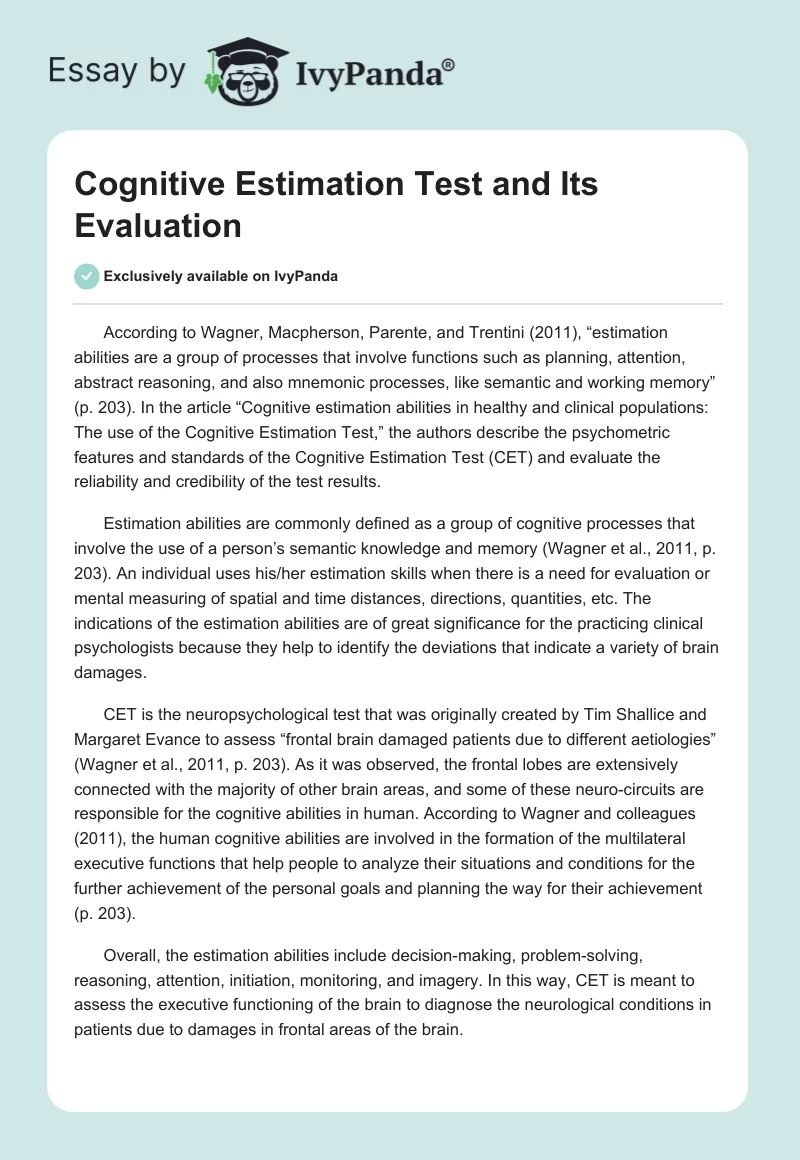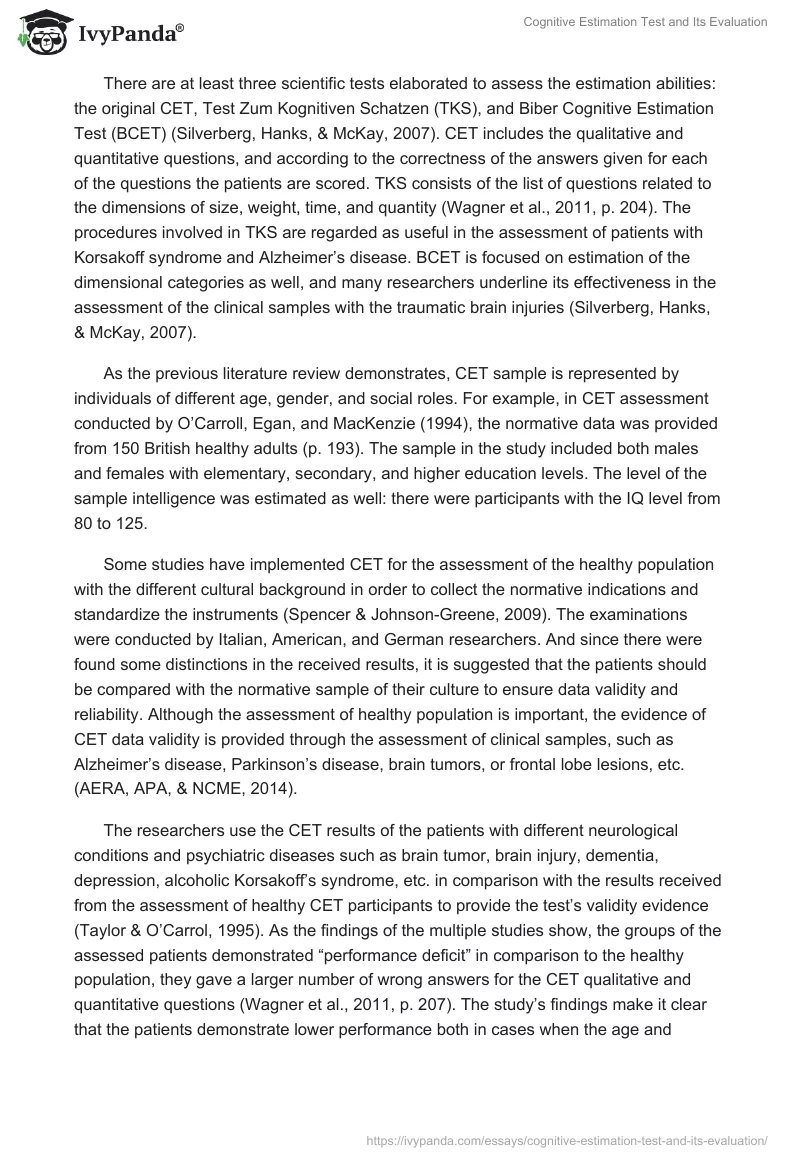According to Wagner, Macpherson, Parente, and Trentini (2011), “estimation abilities are a group of processes that involve functions such as planning, attention, abstract reasoning, and also mnemonic processes, like semantic and working memory” (p. 203). In the article “Cognitive estimation abilities in healthy and clinical populations: The use of the Cognitive Estimation Test,” the authors describe the psychometric features and standards of the Cognitive Estimation Test (CET) and evaluate the reliability and credibility of the test results.
Estimation abilities are commonly defined as a group of cognitive processes that involve the use of a person’s semantic knowledge and memory (Wagner et al., 2011, p. 203). An individual uses his/her estimation skills when there is a need for evaluation or mental measuring of spatial and time distances, directions, quantities, etc. The indications of the estimation abilities are of great significance for the practicing clinical psychologists because they help to identify the deviations that indicate a variety of brain damages.
CET is the neuropsychological test that was originally created by Tim Shallice and Margaret Evance to assess “frontal brain damaged patients due to different aetiologies” (Wagner et al., 2011, p. 203). As it was observed, the frontal lobes are extensively connected with the majority of other brain areas, and some of these neuro-circuits are responsible for the cognitive abilities in human. According to Wagner and colleagues (2011), the human cognitive abilities are involved in the formation of the multilateral executive functions that help people to analyze their situations and conditions for the further achievement of the personal goals and planning the way for their achievement (p. 203).
Overall, the estimation abilities include decision-making, problem-solving, reasoning, attention, initiation, monitoring, and imagery. In this way, CET is meant to assess the executive functioning of the brain to diagnose the neurological conditions in patients due to damages in frontal areas of the brain.
There are at least three scientific tests elaborated to assess the estimation abilities: the original CET, Test Zum Kognitiven Schatzen (TKS), and Biber Cognitive Estimation Test (BCET) (Silverberg, Hanks, & McKay, 2007). CET includes the qualitative and quantitative questions, and according to the correctness of the answers given for each of the questions the patients are scored. TKS consists of the list of questions related to the dimensions of size, weight, time, and quantity (Wagner et al., 2011, p. 204). The procedures involved in TKS are regarded as useful in the assessment of patients with Korsakoff syndrome and Alzheimer’s disease. BCET is focused on estimation of the dimensional categories as well, and many researchers underline its effectiveness in the assessment of the clinical samples with the traumatic brain injuries (Silverberg, Hanks, & McKay, 2007).
As the previous literature review demonstrates, CET sample is represented by individuals of different age, gender, and social roles. For example, in CET assessment conducted by O’Carroll, Egan, and MacKenzie (1994), the normative data was provided from 150 British healthy adults (p. 193). The sample in the study included both males and females with elementary, secondary, and higher education levels. The level of the sample intelligence was estimated as well: there were participants with the IQ level from 80 to 125.
Some studies have implemented CET for the assessment of the healthy population with the different cultural background in order to collect the normative indications and standardize the instruments (Spencer & Johnson-Greene, 2009). The examinations were conducted by Italian, American, and German researchers. And since there were found some distinctions in the received results, it is suggested that the patients should be compared with the normative sample of their culture to ensure data validity and reliability. Although the assessment of healthy population is important, the evidence of CET data validity is provided through the assessment of clinical samples, such as Alzheimer’s disease, Parkinson’s disease, brain tumors, or frontal lobe lesions, etc. (AERA, APA, & NCME, 2014).
The researchers use the CET results of the patients with different neurological conditions and psychiatric diseases such as brain tumor, brain injury, dementia, depression, alcoholic Korsakoff’s syndrome, etc. in comparison with the results received from the assessment of healthy CET participants to provide the test’s validity evidence (Taylor & O’Carrol, 1995). As the findings of the multiple studies show, the groups of the assessed patients demonstrated “performance deficit” in comparison to the healthy population, they gave a larger number of wrong answers for the CET qualitative and quantitative questions (Wagner et al., 2011, p. 207). The study’s findings make it clear that the patients demonstrate lower performance both in cases when the age and education variables are matched with the healthy participants or when they are not matched.
The diapason of correct answers and deviations was developed according to the answers of the normative group. The traditional CET scale elaborated by Shallice and Evance divides the scores into “normal, quite extreme, extreme, and very extreme” (Shallice & Evance, 1978).
As the researchers claim, the normative scores are equal to indication between 0 and 20 while the higher scores imply deviation from a norm. According to O’Carroll and colleagues (1994), the variables of age, gender, social status, IQ, and educational level may influence the CET results (p. 195). It means that the test performance is dependent on the individual characteristics of a person. For example, “men and the highly educated tending to give more accurate estimations than women and those who are less educated” (Spencer & Johnson-Greene, 2009, p. 373). Therefore, the CET results may appear to be inconsistent.
In their evaluation of the healthy sample CET performance, O’Carroll and colleagues (1994) analyzed the tests’ psychometric properties through the factor analysis also known as varimax rotation; according to the findings, the deviation of demographic variables was 64.4% (p. 195). The internal reliability analysis conducted by the researchers helps to identify the reliability coefficient. According to O’Carroll et al. (1994) estimations, Cronbach’s alpha equalled 0.40, and Guttman’s reliability coefficient was 0.35.
The cognitive estimation functioning is complex in its nature, and as the multiple research findings demonstrate, it may be not completely reflected by the executive functioning of a person. As the result, the design of the estimation aptitude tests is complicated. To increase the reliability of the test performance “it is important to ascertain which basic abilities are being allocated to each question in the task” (Wagner et al., 2011, p. 208). It is also important to make relatively simple questions to avoid the patient’s guessing and absence of reasoning in answers. The questions must be formed to ensure the involvement of individual’s decision-making, semantics, and the working memory so that the patient will not be able to apply the knowledge stored in his long-term memory.
Conclusion
CET is implemented in clinical practice to detect damages and injuries in the assessed individuals. CET is commonly associated with the executive dysfunctions and the frontal lobes impairments (Wagner et al., 2011, p. 203). The testing is used for evaluation of the clinical sample conditions such as Alzheimer’s disease, Korsakoff syndrome, and others.
As the research studies demonstrate, the CET was observed to be effective in assessments of the psychiatric and neurological conditions; however the findings demonstrate that the testing performance results may be inconsistent and diffused due to multiple variables affecting CET outcomes. To ensure a high level of validity and reliability of the received data, a physician needs to take into consideration multiple criteria and factors that are basically are dictated by each individual case. It is important to pay attention to age, gender, and especially educational level variables as it was observed to have the most significant impact on the testing results (Taylor & O’Carrol, 1995).
Moreover, a physician needs to take into consideration many neuropsychological processes involved in the CET assessment process to ensure that estimation functions are being evaluated. When the CET questions are well-developed, the testing results may be of significant use in the diagnosis establishment. CET may be regarded as an effective method of clinical sample assessment that can be implemented along with other techniques of patients’ examination.
References
American Educational Research Association, American Psychological Association, & National Council on Measurement in Education (2014). Standards for Educational and Psychological Testing. Washington, DC: AERA Publications. Web.
O’Carroll, R., Egan, V., & MacKenzie, D. M. (1994). Assessing cognitive estimation. British Journal of Clinical Psychology, 33, 193–197. Web.
Shallice, T., & Evans, M. E. (1978). The involvement of the frontal lobes in cognitive estimation. Cortex, 14, 294–303. Web.
Silverberg, N. D., Hanks, R. A., & Mckay, C. (2007). Cognitive estimation in traumatic brain injury. Journal of the International Neuropsychological Society,13(5), 898-902. Web.
Spencer, R., & Johnson-Greene, D. (2009). The Cognitive Estimation Test (CET): Psychometric limitations in neurorehabilitation populations. Journal of Clinical & Experimental neuropsychology, 31(3), 373-377. Web.
Taylor, R., & O’Carroll, R. (1995). Cognitive estimation in neurological disorders. British Journal of Clinical Psychology, 34, 223–228. Web.
Wagner, G. P., Macpherson, S. E., Parente, M. A., & Trentini, C. M. (2011). Cognitive estimation abilities in healthy and clinical populations: The use of the cognitive estimation test. Neurological Sciences, 32(2), 203-10. Web.


